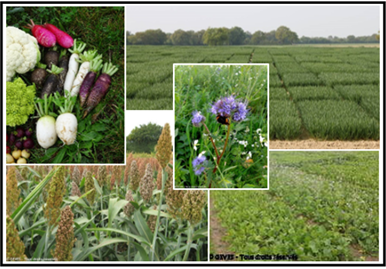Agroecology
What is agroecology?
Agroecology is a concept that puts biodiversity and ecological processes at the heart of agriculture. It includes all techniques that allow agricultural practices to be more respectful of the environment and its ecological specificities. As it is largely based on increased crop services, agroecology leads to a need for more species, varieties and functional diversity.
Which varieties for agroecology?
The Plenary Committee of the CTPS (French Technical Committee for Plant Breeding) asked the Scientific Committee of the CTPS to shed light, based on scientific and technical literature, on the implications of the agricultural transition to agroecology in terms of variety species, breeding, evaluation and seed production.

From September 2020 to March 2021, the Scientific Committee examined the needs in terms of species, varieties, seeds and seedlings, and genetic diversity with regards to agroecology. It also looked at the possibility of participatory breeding and evaluation in agroecology. On the basis of these elements, the committee reflected on the evolution of the regulatory system for variety listing, its implementation, and the dissemination of listing results.
The conclusions of this committee were presented to the Plenary Committee of the CTPS in November 2021.
They appear in full in the report “Which varieties for agroecology?” (French version available only). An executive summary of the key messages and conclusions of this work is available in English.
This report will contribute to the SPAD2 plan, published in November 2021 by the French Ministry of Agriculture. It is an important contribution to the reflection on the future of agriculture, the necessary evolution of the range of varieties on offer, and how we can build this range, and the role of the CTPS in the orientation and evaluation of genetic progress.
The Agroecology report highlights the need to think about and create, and therefore evaluate, a variety in its production system, leading to a more refined combination of genetic improvement, agronomy, and also, more broadly, all the methods and resources for the management and protection of these agroecological cover crops. A rethinking of interdisciplinarity is essential. The agroecological transition will require all technology to be mobilised to achieve this objective. The success of this major transition in terms of the supply of species, varieties, seeds and seedlings requires that the dynamic be not only French, but also European and international.
Conclusions of the committee
The reflection carried out by the CTPS Scientific Committee emphasises that agroecological agriculture will lead to the cultivation of more species and varieties, with increased diversity.
This diversity will have to be taken into account in variety trial networks, by integrating agroecological growing conditions into the trial networks, and combining field trials and evaluation under controlled conditions.
The CTPS will have to evaluate new criteria for national listing, while ensuring the competitiveness of the National Listing system. In an agroecological context that implies more diversity and requires more characteristics to be assessed, the CTPS has a role to play as a trusted third party and as a guide through the dissemination and integration of varietal data in an agroecological context. It is able to integrate results at national level, in relation to pre- and post-listing data) and in relation to European data. The integration of varietal data at European level will require common criteria evaluated in relation to agroecology, while maintaining national specificities with regards to specific needs of their seed sectors and promoting local adaptations.
The evaluation of varieties at the time of their listing on characteristics linked to the common goods they provide (resistance to pests, tolerance to extreme conditions, etc.) will make it possible to direct genetic progress towards jointly developed objectives, in line with the transition to agroecological agriculture.




